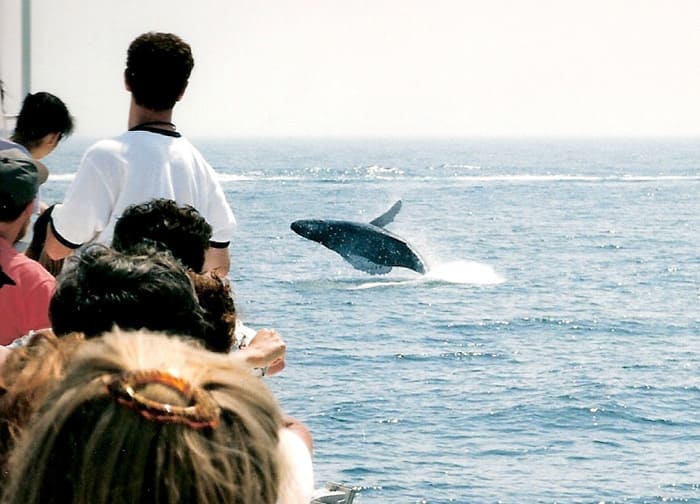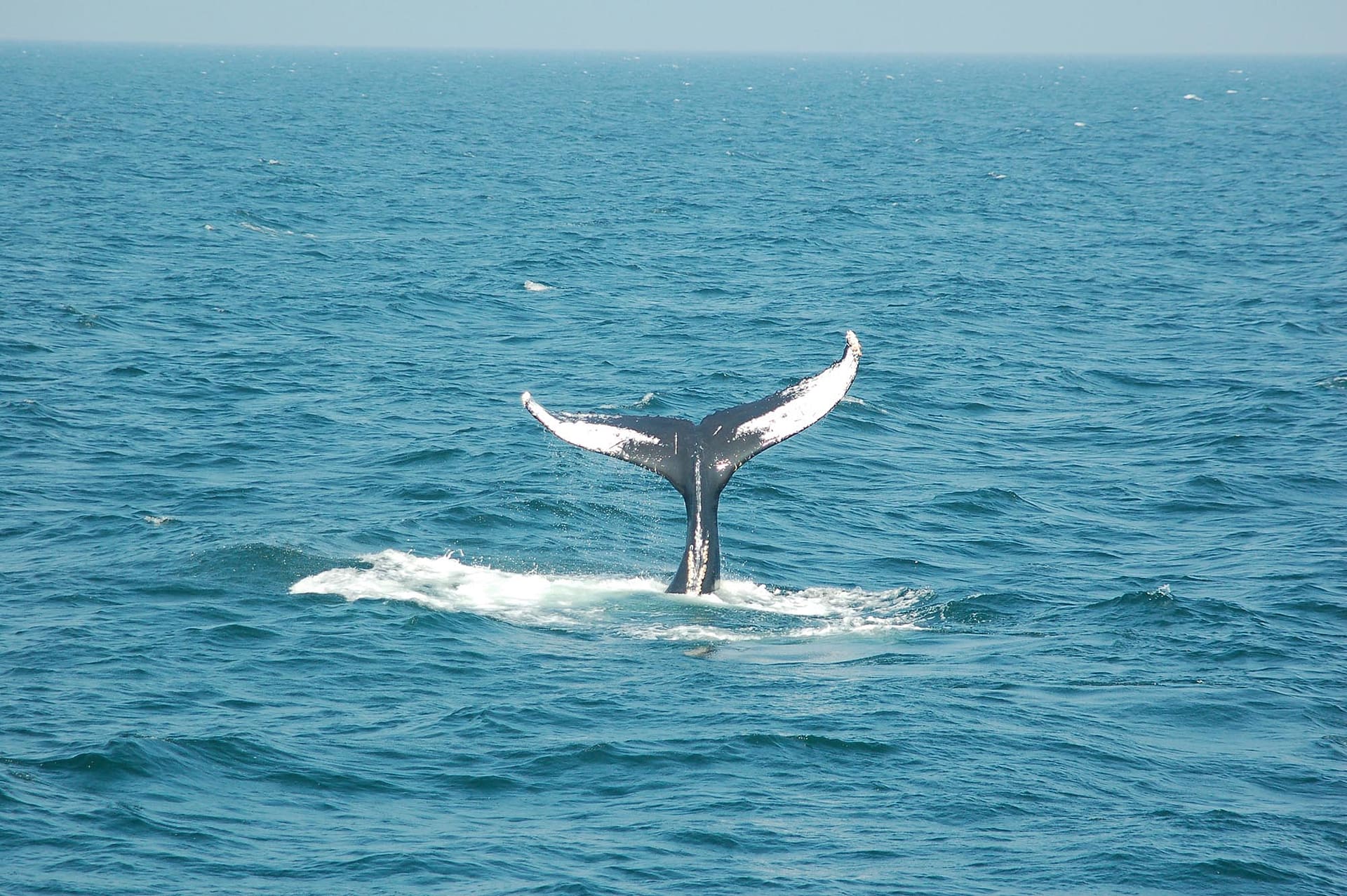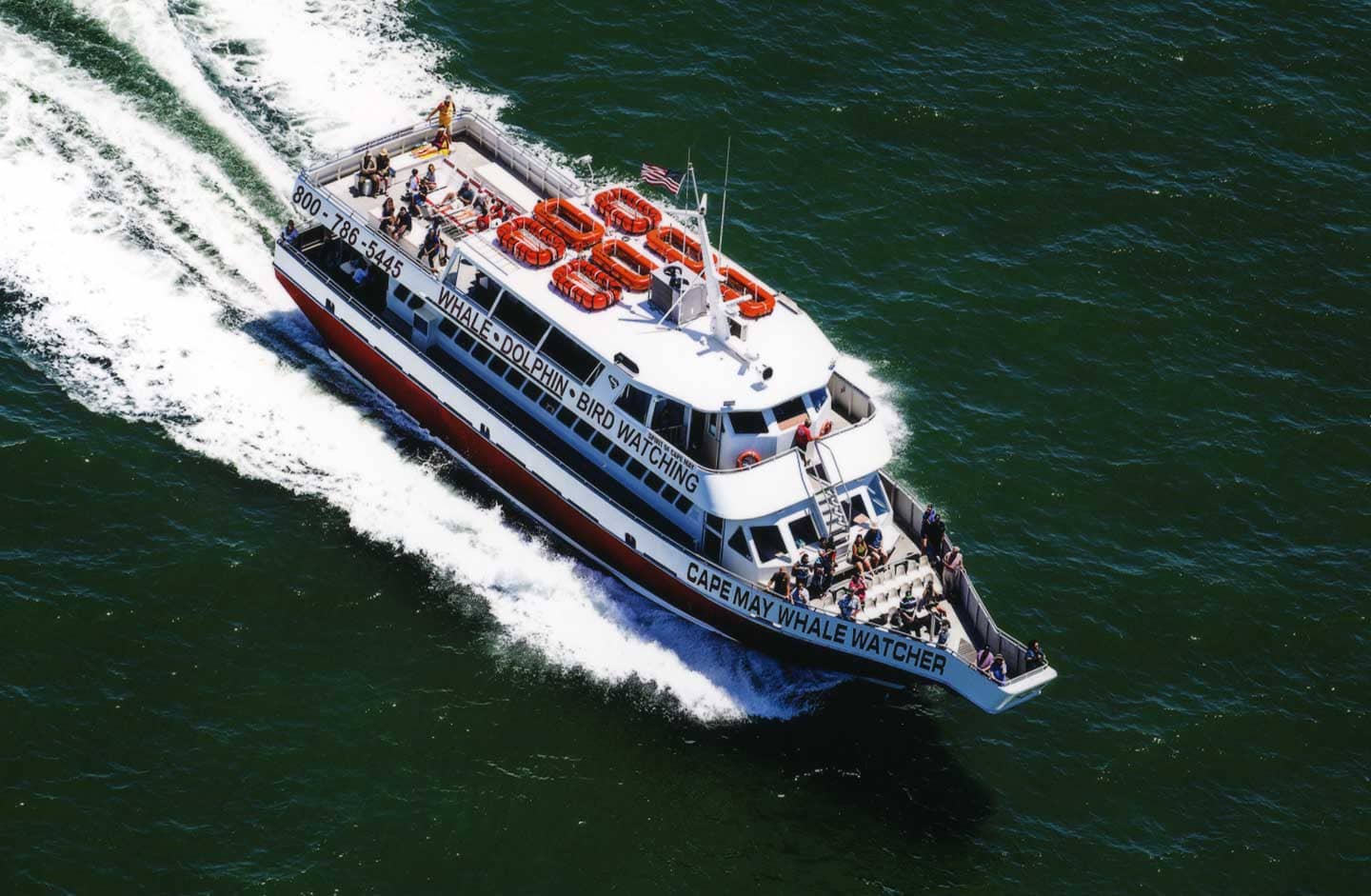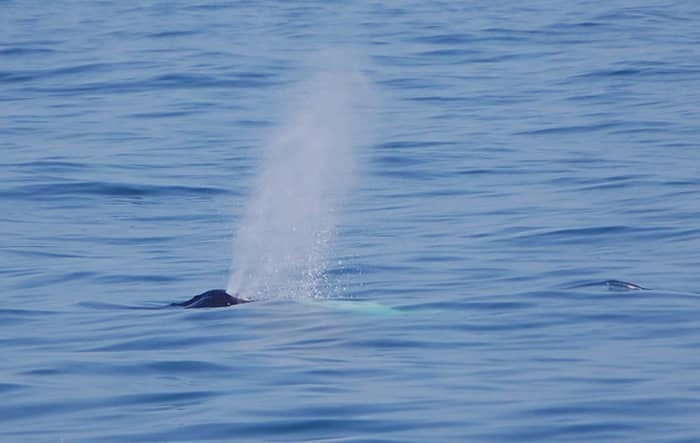Humpback Whale Migration
When is the best time to see a whale in Cape May, New Jersey?” This has got to be the number one question on the lips of every customer.
"When is the best time to see a whale in Cape May, New Jersey?" This has got to be the number one question on the lips of every customer who rides the Cape May Whale Watcher since we started our business in 1993. After over 26 years of whale watching in Cape May, Wildwood, Stone Harbor, Avalon, Sea Isle City, Ocean City, and Atlantic City, New Jersey as well as off the coasts of Lewes, Rehoboth Beach, Bethany Beach, and Indian River, Delaware, the answer is still complicated.
A great many "researchers" will tell you that the whales we see off the coast of Cape May, NJ are migratory species. They base this limited knowledge off of summer or two of "study" which equates to a few days a week on the water and the notes from other college kids who have done the same before them. They also go with what their professors tell them and large organizations like NOAA Fisheries Management and the Whale and Dolphin Conservation Society tell them. The problem with this type of blind faith is that zero people from NOAA or the Whale and Dolphin Conservation Society are making excursions out of New Jersey with any regularity to verify these claims or back them up.
Fortunately, the Captain and Crew aboard the Cape May Whale Watcher have a great deal more experience in terms of data collection and scientific facts than interns or scientists. Wait a minute, Captain. You are not a scientist, how could you possibly know what you are talking about? That is actually easier to explain that the science behind a statement like "all Humpback whales migrates from the southern waters of the Caribbean to the cooler waters of the Gulf of Maine every year."
Science is about observation. The Captain of the Cape May Whale Watcher since we opened in 1993 has been one man, Captain Jeff Stewart. In 2003, I, Jeff Stewart Jr, also became a Licensed Captain. Since that time, there have been two Captains of the Cape May Whale Watcher with the occasional Relief Captain like Captain Miles Lentz and Captain Jack McDevitt, both who had long years of experience in whale and dolphin watching prior to running our vessel. Captain Miles Lentz ran Captain Ron Robbins Whale Watcher from the Cape May Whale Watch and Research Center for many years prior to coming aboard with Cape May Whale Watcher. The point of this comes down to observation and the number of trips recorded.
In a given season, we start running sporadic weekends in March. We add a few more trips in April, and then we start running daily in May, adding trips up to Memorial Day when we reach our full schedule of three trips daily. Once we achieve our three trips daily out of Cape May, New Jersey, we stick with this schedule through June, July, August, and September. Once October rolls around the scheduled lesson. The Captains get a break. We then run weekends in November and December and a few pelagic birds watching trips in January and February. So barring the outliers, the real season is May, June, July, August, September. Five months, 30ish days times five months is around 150 days with three trips a day is around 450 trips per season, roughly, leaving room for weather days and missed weather trips. Add in the weekends and other variety, we can call it around 500 trips.
Captain Jeff Stewart, the founder of Cape May Whale Watcher in 1993, actually had his start with another company prior to this, in Wildwood Crest, at Sinns Dock, Captain Ronald Sinn as his mentor. The seasons were shorter than, with around 100 days and three trips daily or 300 trips. Captain Jeff Stewart ran this schedule for around 20 years prior to opening Cape May Whale Watcher. That comes out to roughly 6000 trips prior to the new business opened. Since 1993, the seasons are longer and the more trips have been made over the last 22 years or roughly another 11,000 trips. Over the last 42 years of whale and dolphin watching, sightseeing, fishing, dinner cruising, lighthouse cruising, and speed boat riding, Captain Jeff Stewart Sr, has accumulated around 17,000 trips. Captain Jeff Sr. still puts in a full schedule this year, though he now skips the morning trip, leaving it to Captain Jeff Stewart Jr.
I have been aboard my father on trips since the Big Flamingo days at Sinns Dock. I started sailing daily in 1990 during the summer months off from school. Even as a young mate, I made three trips daily. Some days I would skip the afternoon trip and sail with Captain John Royals aboard the fishing boat Royal Flush. At the young age of eight, nine and ten, these were long days, but still, the powers of observation developed at a young age. I have been at my father's side every summer since as a mate until I received my 100 Ton Masters License in 2003. I continued to work summers only as relief Captain until I graduated in 2004 with a Bachelors of Science in Business Management in 2004. After this, I became a full-time Captain. Now on my thirteenth year as the Captain of the Cape May Whale Watcher, I have logged over 6000 trips.
These numbers are not meant to impress, however when you compare powers of observation of an intern that invests a summer or two of sporadic trips into whale and dolphin watching versus a boat Captain who invests his life and his family into whale and dolphin watching, the results are going to be dramatically different. I can tell you from experience this is more than an investment of time and sacrifice, but we will save that for another blog. The point is, we not only observe, record, photograph and track these Humpback Whales, but we get to know them from sighting to sighting, from year to year. We put more than science into our observations which is probably to our detriment, but IMO, we have a higher level of authority to talk about Humpback Whales off the coast of New Jersey than your average researcher. I'm guessing I just offended a scientist or two. I would like to preface that with I have the utmost respect for scientists and if I had not followed the path my life has followed, I would be a scientist.
Since Fifth Grade, I entered in Science Fairs and loved the Scientific Method. I competed in Science Fairs through High School and one First place multiple times, all the way to the state level one year only to come home with second in Environmental Science. In any case my background may not be that of a Scientist, however, I do have a mind for Science. We have also established that I have the opportunity to observe Humpback Whales hundreds of times per year.

Over the years I myself have talked about the great migration of Humpback Whales from the warm waters of the Caribbean to the cooler food-rich waters off of the North East. As a Naturalist and a Captain, I would talk about the Humpback Whales we saw as a transient, passing through on the way to their destination. It was not until around 2009 that I got a copy of the Gulf of Maine Catalog which seemed like the best-kept secret in Whale Watching. To provide some background, you should probably understand the Humpback Whale ID.
Each Humpback Whale is photographed and has unique characteristic markings on their body. Their dorsal fins can have unique shapes and markings. Their rostrum can also have unique shapes. The most unique and highly distinctive feature of a Humpback Whale is their tail. The underside of the Humpback Whale's Tail is unique on every Humpback Whale. It is the equivalent of a fingerprint for the whale. It is a variation of all black to all white, or patterns of black and white. These patterns make photo ID easier. Emphasis on the "er." Nothing is easy with the naked eye. The Gulf of Maine Catalog is organized from all black tails or flukes to all white flukes and in the middle, the balance is 50/50. That having been said there are around 600 pages with 6 flukes per page. That is a whole lot of tail to look at……

In any case, what is more, difficult to swallow than 3600 whales to look through to determine which whale you have photographed is to then grasp the idea that there are over 12,000 Humpback Whales in the Atlantic Ocean! YIKES. Customers tell us all the time, "just look in the catalog, all the whales are photo identified!" Actually, only 30% are. Yes many of this endangered species, Megaptera novaeangliae are photo identified in an area that sees an influx of whales annually. However, that leaves an abundance of whales which are not photo identified.
These humpback whales remain anonymous for a multitude of reasons. Many humpback whales spend a large part of their life far offshore, avoiding busy shipping lanes which run parallel to the coast near shore where boaters encounter whales and where researchers can easily look. These offshore Humpback Whales which migrate 100 miles offshore move swiftly at 4-7 knots and indeed travel past Cape May, NJ never even knowing it exists. Other Humpback Whales simply do not fluke (take a deep enough dive to display their tail flukes). The reasons usually are because of shallow water or baitfish which are on the surface or mid-water instead of deep water.
The bottom line is that there are a large number of Humpback Whales that do migrate and regularly get photographed by boaters and whale watchers. There is an even greater number, almost three times as many, which do not. The Atlantic Ocean is a vast area to cover, and we are only looking at the surface on any given trip. Even if you take into account, the majority of the life in the ocean exists within the confines of the continental shelf in relation to land, this still leaves thousands of square miles.
However, we talked about observation and kind of got off topic. To put us back on the topic of observation and whale watching and experience, this sums up my own observation as a Whale Watching Captain for 6000 plus trips. After photographing hundreds of individual Humpback Whales, many of which do not a fluke, of the whales that do fluke, about 20 percent are included in the Gulf of Maine Catalog. The remaining 80 percent are anonymous Humpback Whales in the eyes of the Whale and Dolphin Conservation Society and NOAA Fisheries. So, it begs the scientific question, if these whales are not in this very organized catalog, where do they go in a given year? Are they migrating at all? From where to where? Why?
We could hypothesize, There is a population of Humpback Whales which are non-migratory. Or we could state that there is a separate population of Humpback Whales which call the Mid-Atlantic States of New York, New Jersey, Delaware, Maryland and Virginia, their home. We can hypothesize all we want however without data to back it up, it seems our ideas are not going anywhere. One working theory my father and I have come up with pertains to the food source of Humpback Whales around New Jersey, New York, and Delaware. I will save these findings for another blog.
SO…..What does this have to do with coming to the shore and going whale watching? The answer to the best time to see whales at the Jersey Shore is not as simple as the average whale watcher would like. We have seen an influx of whales in one year, like 2015 in both the summer and fall months. Another year like 2001 saw an influx of whale sightings in the spring of the year and then late summer. Another year, like 1992 saw the majority of sightings in Summer Only. The guarantee of seeing a whale does not exist here. Do we see whales? Yes! Do we see whales often? Yes! Can we guarantee whale sightings? No….. If we could we would and I have many people interpret our Marine Mammal Sightings Guarantee as a guaranteed whale sighting with a money back guarantee…. This is not the case.
In 1993, we originated the Marine Mammal Guarantee. Captain Jeff Stewart Sr, stated, "If Whales or Dolphins or Porpoise, are not sighted on your trip, you get a Free Pass to ride again free of charge."This Free Pass Never Expires, so use it tomorrow, or use it ten years from now." This first for the state of New Jersey commercial passenger-carrying industry led to many variations of it, none of which guarantee whales or money back. The guarantee was developed and offered to allow customers who had poor trips, due to mother nature, whether or just the nature of dolphins and whales, to come back, stress-free, and finally get the trip they wanted. For the tens of thousands of free pass holders, it has done just that. A money back guarantees would be impossible, because, if we do not see Marine Mammals, we still have mortgages, fuel bills, insurance costs, crew costs, wear, and tear, etc….
So, migratory whales are a possibility some of the time in New Jersey. More likely, you will see some of the Mid-Atlantic States population of Humpback Whales feeding on the massive amounts of menhaden which are found in the waters around Cape May. You may also not see a whale at all, but rather hundreds of Atlantic Bottlenose Dolphins, feeding on the same Menhaden. Some say the dolphins can be more entertaining when you find a logging Humpback Whale, others are fortunate enough to see Lunge Feeding and Breaching Humpback Whales at a fraction of the cost of going to Maine, Alaska or Hawaii.
At the end of the day, the nature of nature is a factor. We are looking for the Spout of a Whale in a one or two miles radius around our boat traveling at 12-18 knots through the water through an area which could be 30 square miles on an average trip, looking for a mammal that can stay underwater for an average of 2-8 minutes, but can stay under for up to 30 minutes. In ideal conditions its a hard job. In adverse conditions like weather, and by whether I don't mean rain, but rather a wind, which makes waves and fog, you start to get an idea for why it is possible to have trips where you miss one of those 12,000 Humpback Whales that are out there.
In any case, the next time someone tells you the only time to see whales is when they are migrating, let them know they better plan on renting a helicopter or airplane for a week or two to make regular trips 100 to 200 miles from shore to catch the great migration. Otherwise, hop aboard with us and come see the resident population in action. Our whales can be seen for months at a time and we offer much better discounts than private jets.
Captain Jeff Stewart Jr.
Source: Captain Jeff Stewart Sr. Personal Log Book
Source: Captain Jeff Stewart Jr. Personal Log Book






